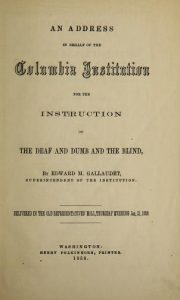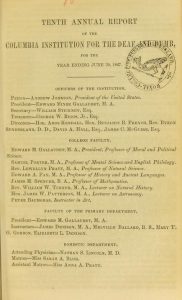~This post courtesy of Katie Healey and Caroline Lieffers, doctoral students in Yale’s Program for the History of Science and Medicine, with additions by Melissa Grafe, John R. Bumstead Librarian for Medical History, Head of the Medical Historical Library.

Title page of An Address in Behalf of the Columbia Institution for the Instruction of the Deaf and Dumb and the Blind by Edward M. Gallaudet, 1858.
In 1856, Amos Kendall, former postmaster general of the United States, became guardian to several deaf children. Concerned by their limited educational prospects, he donated two acres of his estate in the capital to establish the Columbia Institution for the Instruction of the Deaf and Dumb and Blind, to be run by Edward Miner Gallaudet. The blind students were soon moved to a separate school in Baltimore. Not satisfied with just secondary education, Kendall convinced Congress to grant the school the authority to award college degrees. In 1864, President Lincoln signed the college’s charter and President Grant signed the diplomas of its first graduates, establishing a tradition of presidential signatures that continues on its diplomas today. The college was renamed Gallaudet College in 1894, in honor of Thomas Hopkins Gallaudet, and became Gallaudet University in 1986.
Gallaudet University in Washington, D.C. is the world’s only liberal arts college specifically for the Deaf and hard of hearing. It remains a center of both Deaf culture and Deaf rights activism. The campus ignited in protest in 1988 and again in 2006 over demands for leadership representative of and responsive to the Deaf community. Widespread coverage of these protests inspired activism by Deaf communities abroad, as well as other disability rights groups.
In 1988 the president of Gallaudet University resigned, and several qualified Deaf candidates emerged as finalists for the position. The mostly hearing Board of Trustees, however, appointed Elisabeth Zinser, a non-signing, hearing woman with little experience with Deaf culture. Students, faculty, staff, and community members united to close down the school for a week in protest. The Deaf President Now (DPN) Movement resulted in the appointment of I. King Jordan as the university’s first Deaf president. The protesters also demanded the resignation of Jane Bassett Spilman, chairwoman of the Board of Trustees, who declared during the protest that “the deaf are not yet ready to function in the hearing world.” This statement reflects audism—discrimination based on audiological status. The NAACP supported the Gallaudet students and saw the protest as a Deaf civil rights movement. In his letter of support,

Beginning of the Tenth annual report of the Columbia Institution for the Deaf and Dumb, for the year ending June 30, 1867. One of the early annual reports for the institution that would later become Gallaudet.
Reverend Jesse Jackson declared, “The problem is that not that the students do not hear. The problem is that the hearing world does not listen.”
For more on Gallaudet and Deaf education and culture, make sure to visit the online exhibition Deaf: Cultures and Communication, 1600 to the Present.





